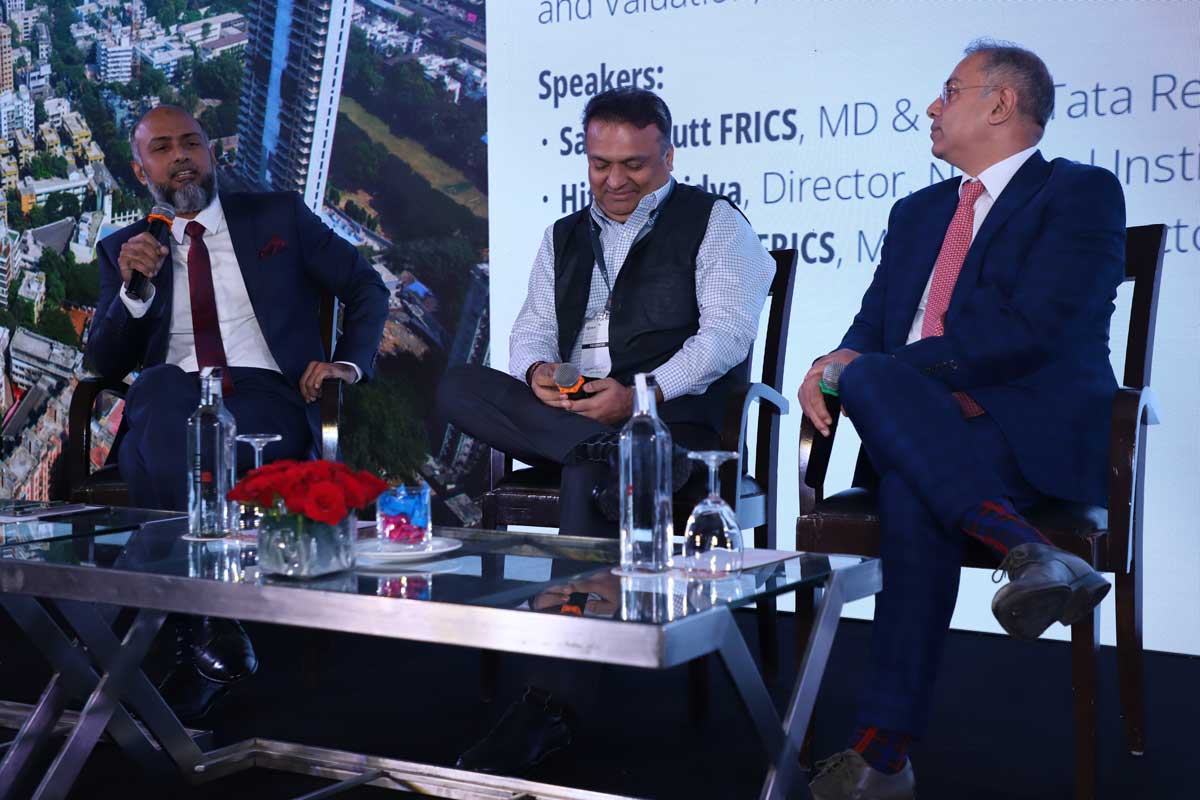Organised by RICS in Delhi on August 3, 2023, The Indian Real Estate: Housing Conference focused on critical issues related to the sector, including demand and supply, policy interventions and providing finance at reasonable rates to bring prices to equitable levels.
The conference began with Ashwani Awasthi, Managing Director - South Asia, RICS, setting the agenda for the day.
India @100: Housing Sector's Role in Shaping the Future
In this session, Gulam Zia, MRICS, Senior Executive Director Research, Advisory, Infrastructure and Valuation, Knight Frank, discussed affordable housing, land prices and catering to the demand of increasingly young home users. Participants included Sanjay Dutt, FRICS, MD & CEO, Tata Realty & Infrastructure Ltd and RICS Conference Chair – South Asia and Vipul Roongta, FRICS, Managing Director and CEO, HDFC Capital.
Key takeaways:
The need to balance the housing needs of workers and professionals with increasing cost of land. An option is the hub-and-spoke model, where affordable housing would be constructed further away, where land is relatively cheaper, and connected to the hubs with good quality infrastructure.
Every home buyer expects the price to appreciate. When interest rates have gone up to 9 per cent and land prices are at an all-time high, how can the price of affordable housing hold?
Affordable housing of sub Rs 75 lakh per unit in most parts of the country and sub Rs 1.5 crore in Mumbai is possible.
Real-estate development is a state subject with regional variations. Working in one region or many is a choice, not something to be tackled through policy.
Many new formats, such as rental and professional housing, have emerged and more will develop.
As India moves towards a more global interest rate, the gap between residential yields and mortgage rates (about a third currently) will close.
Demand for housing will grow as construction and manufacturing pick up pace. The problem is supply. The country must make homes for workers. For example, Tata Housing recently made 1.5 million sq ft of housing for women in just six months, “a small Jamshedpur, of sorts” – an initiative worth replicating.
Capacity Building and Empowering Talent
The discussion in this session was led by Rajiv Nehru, MRICS, In Market Product Lead - South Asia, RICS. Prof TG Sitharam, Chairman, AICTE; Dr Charru Malhotra, Professor, Indian Institute of Public Administration; Sumanth Reddy, Managing Director, India Institute of Real Estate; Prof Dr. Deepak Bajaj, FRICS, Director and Head of Institution, RICS School of Built Environment, Amity University; and Vivek Rathi, National Director -Research, Knight Frank India, participated.
Key takeaways:
Students should be made employable.
To have at least four to five years of site experience before taking on management roles, engineers require industry support to teach them basics such as quantity surveying.
A strong case was made for PPPs in construction education and experiential learning.
The RICS institute is a training ground for engineers to be trained in managerial skills. It now functions as a centre of excellence in academics, with about 80 per cent of students coming with prior work experience.
Transforming Urban Spaces: Redevelopment, Rejuvenation and Sustainable Growth
This session was led by Preetham Mehra, MRICS, Senior Executive Director, CBRE. Panellists included Manisha Bhartia, Urbanism Director, BDP; SV Goyal, CEO & WTD, Reliance MET of the Reliance Model Economic Township Ltd (MET) city; and Mili Majumdar, Managing Director, GBCI India and Senior Vice President, US Green Building Council.
Key takeaways
The industry can plan more than basic adherence to rules. For instance, in the Deen Dayal Upadhyay Jan Awas Yojana (DDUJAY), the roads mandated at 9 m were enhanced to 12 m, enabling more efficient future management.
Industrial roads of more than 18 m allow easy movement of vehicles, even during loading and unloading.
Innovative payments for land such as Rs 30,000/acre per month for 33 years allow easy acquisition and steady payment to landowners.
Masterplans in large projects need to be fluid documents that can be revisited and modified according to current market requirements.
We need to decarbonise to make buildings resistant to climate change.
Circularity of urban spaces, revitalising ageing spaces and accounting for embodied carbon when planning, remodelling or demolition are important.
Revitalisation can only take place with robust data collection at the lowest level and a strong IT backbone.
Structural plans should be robust; reuse as much as possible should be the mantra; and masterplans should keep up with new architecture by remaining flexible.
Smart technologies for streetlights could push energy savings of up to 25 per cent.
Supervisory control and data acquisition (SCADA) for wastewater treatment and a high focus on renewable energy as well as landscape and pedestrian walkways could get green township ratings in the Reliance township.
Proptech - An Evolving Scenario
Sanjay Dhyani, Executive Director - Project & Development Services, JLL, led the discussion. Speakers included Vivek Agarwal, Co-Founder & CTO, Square Yards; Manish Agarwal, SVP - Investments and Strategy, HDFC Capital; Pankaj Kapoor, MRICS, Founder and Managing Director, Liases Foras; Angie Mahtaney, Business Mentor, Brigade REAP; and Shashank Vashishtha, MRICS, Executive Director, EXP Realty.
Key takeaways
Data acquisition and management have brought structure to the industry.
Proptech is the flavour of the season and newer startups are focussing on different aspects of consumer needs as well as efficient management of systems.
Proptech is very relevant to the industry with the solutions it offers.
Unleashing the Future of Last Mile Funding
This discussion was moderated by Saurabh Mehrotra, MRICS, Executive Director, Valuation & Advisory, Knight Frank, and the keynote address was delivered by Soloman Arokiaraj, IAS, Joint Secretary - Infra Finance Secretariat, Department of Economic Affairs, Ministry of Finance. The panel included Sharad Mittal, MRICS, former Executive Director and CEO - Real Estate Funds, Motilal Oswal Alternates; Amit Goenka, MRICS, CEO, Nisus Financial Services; Getamber Anand, Chairman, ATS Infrastructure Ltd; and Nikhil Kejriwal, Principal Investment Officer, SWAMIH Investment Fund.
Key takeaways
Funds find it difficult to lend to stuck projects most times because registrations have lapsed, financial records are poorly maintained and bookmaking takes time.
Of the number of projects that apply, Swamih manages to lend to about 10 per cent while Nisus manages to lend to just 3 per cent.
Even when funds are available, sitting lenders often make lending difficult.
The good news is that markets have changed in the past three to four years.
Despite protection under the Insolvency and Bankruptcy Code (IBC), the troubles of 2013-20 do not allow existing lenders to fulfil their commitments.
Despite prices having gone up, projects with unsold inventory have to be monetised or sold at discounted prices to asset reconstruction agencies or the IBC.
Data analysis shows that the march to the IBC by homebuyers has been reversed.
Even resolutions within the IBC are going for Reverse Corporate Insolvency Resolution Processes (CIRP) under the National Company Law Appellate Tribunal (NCLAT).
With the IBC taking a minimum of 36-48 months for resolution, the industry needs a fast-track mechanism.
The last-mile fund must take care of payment and discharge of land, lenders’ dues, statutory dues and construction.
A call was made for a new order where projects plan for financial closure and keep enough capital for a rainy day.
A Policy Intervention Committee under the chairmanship of former Niti Aayog chairman and G 20 Sherpa, Amitabh Kant, was seen as a ray of light.
Arokiaraj promised to carry the requests to study the viability of IBC protection for AIF capital flow; determine the waterfall mechanism to make the IBC in real estate a fast-track mechanism; and look into an infrastructure finance secretariat.
Real Estate Housing Sector: Emerging Stronger & More Optimistic Than Ever Before
Santhosh Kumar, Group Vice Chairman, ANAROCK Property Consultants, led this final session. Panellists included Tarun Mehrotra, Regional Business Head - North & East India, Tata Housing; Dr Ananta Singh Raghuvanshi, MRICS, President, NAREDCO Mahi; Rishi Raj, Chief Operating Officer (COO), Max Estates Ltd (MEL); Kunal Behrani, Chief Operating Officer, Jagdish; and Chakresh Jain, Chairman of the Board, Capricot Technologies Pvt Ltd.
Key takeaways
Demand has not reached levels of over 5 lakh as during the peak of the housing boom in 2012-13. That was largely investor and speculation-driven rather than construction driven by developers.
Genuine demand prompted by an aspirational lifestyle has been seen from end-users in 2023-24; it currently stands at 3,65,000 units. Also, prices have gone up.
RERA accounting should become uniform – for instance, even accounting between Gurugram and Noida, within the National Capital Region, is different.
RERA should be consistent for grading of projects by industry agencies to make information transparently available to homebuyers.
Premium demand rising to 29 per cent and the dip in demand for affordable housing points to a K-shaped recovery post COVID. There is a case to be made for lower income tax on such projects for developers and large interest rebates for the affordable sector.
About 55 per cent of demand is from 35-40 year olds.
There is great opportunity for Tier 2 and 3 cities as manufacturing has moved there. The 18 per cent growth of the service sector in these 3 cities bodes well for a spread-out growth in real-estate demand.
While everyone bought land earlier, professionals are now looking for ready products.
Many people are investing for a rental income in a post-COVID world as a safety net. This has drawn them back to assets in their own towns, from 6.3 per cent in 2006 to 30+ per cent now.
We need a regime that cuts out uncertainty, with a focus on design, construction and delivery to owners, and all stakeholders on a common platform, a common data environment.
End-users need all the lifestyle amenities and other boxes ticked and good for at least 20 years. Thus, everything must be researched – security, fitness and public transport connectivity.
The evening closed with the presentation of the first RICS South Asia awards.


















